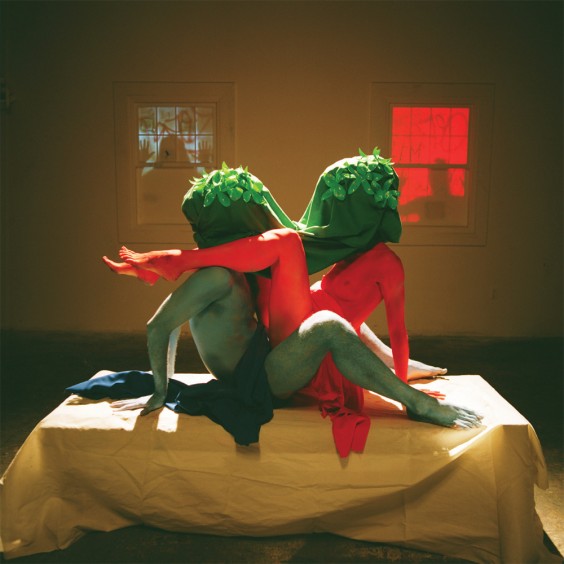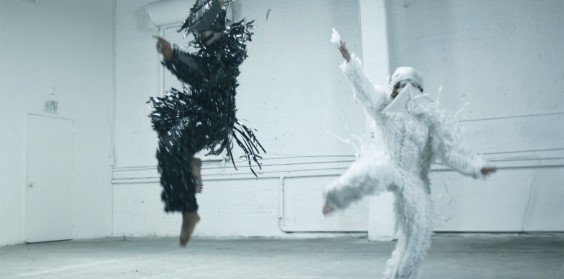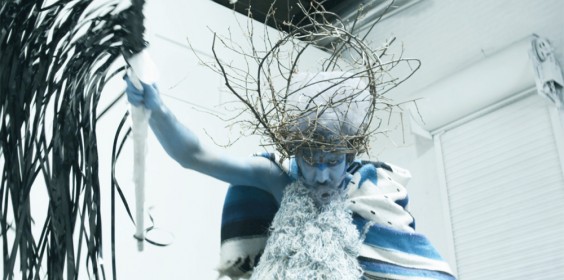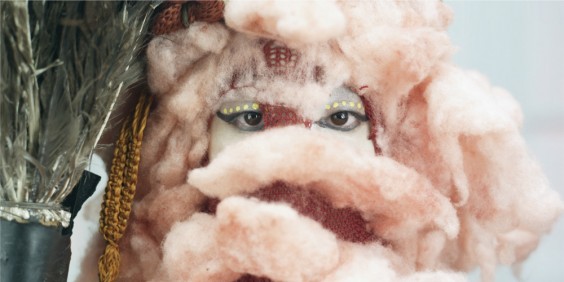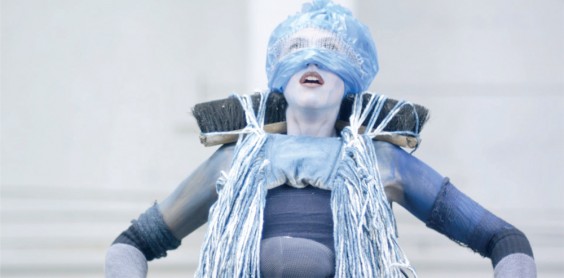In the print edition of Chromatic: The Crossroads of Color and Music, this feature story was improperly credited. We regret the error.
 NewVillager: New Villager (IAMSOUND, 8/16/11)
NewVillager: New Villager (IAMSOUND, 8/16/11)
New Villager: “Lighthouse”
[audio:https://alarm-magazine.com/wp-content/uploads/2011/08/NewVillager_LightHouse.mp3|titles=NewVillager: “Lighthouse”]As a captivating yet mystifying merger of music, art, performance, and color, NewVillager is an otherworldly project that centers on an elaborate mythology that drives the collective’s creative process. The group’s still-unfolding allegories revolve around three main colors — red, green, and blue — representing past, present, and future, respectively, while black and white signify catabolic and anabolic forces.
With these as background, the project’s principals — Ben Bromley and Ross Simonini — use a large cast of contributors to depict different aspects of its creation myth via songs, videos, and installation art. One such song and subsequent video, “Lighthouse,” depicts a fantastical vision that features a set of ornately costumed crimson- and sapphire-hued characters. Like many NewVillager creations, this piece draws inspiration from multiple disciplines — in this case, Papua New Guinean tribal aesthetics, Robert Smithson’s art installations, and Sergei Parajanov films.
Bromley and Simonini (who is an editor at The Believer) have played together in other bands, but NewVillager has allowed them to merge their interests in music and art. The self-proclaimed “musical omnivores” glean influences from Walter Murch, Foley sounds, folk melodies, and electronic beats and mix in elements of installation art to create distinctive performances, which incorporate the project’s mysterious narrative in some fashion.
“NewVillager mythology is the primary medium in which we work,” Simonini says. “We’re interested in approaching the relatively abstract idea of the mythology through as many possible senses, ideas, and mediums as a way of making it more concrete.”
In January of 2010, NewVillager partnered with fellow artists, writers, and filmmakers to create Ecotone, an art installation exhibit at Lowerdeck, an under-the-radar gallery in San Francisco. The concept of Ecotone, defined as a transition between environments, centered on the shifting perception of home, with each artist offering his or her personal perspective via art and video installations. NewVillager’s contribution successfully blurred the lines between art installation and music performance and barraged viewers with a visual and auditory feast. The Ecotone show is one of many ways that Bromley and Simonini have forged connections with fellow artists and have brought them into the creative fold of NewVillager mythology.
“We’re always reaching out for collaboration opportunities,” Bromley says. “The mythology was designed to facilitate collaborations, to create a language that multiple people can use.”
NewVillager also has taken its innovative performance style on the road and has created off-the-cuff shows in some otherwise mundane locations, such as a tunnel viaduct along a Chicago interstate. Not all passers-by were amused by the group’s antics, but one woman pulled over to find out what all of the commotion was about. She quickly joined in the fun and morphed into Bright Man, one of the characters in that night’s performance.
Though NewVillager’s performances and art shows are incredibly varied, Bromley and Simonini reference distinctive rituals and symbolism to create a sense of cohesiveness throughout their projects. One consistent element of their work is a set of ten symbols that signify the various transformative stages of the creative process that informs NewVillager mythology. The final symbol in the set, which appears in the group’s art and in the opening sequence of “Lighthouse,” encapsulates the complete revelation of the NewVillager mythos and signifies the creative transition between the end of one endeavor and the beginning of another.
The symbols also act as a common thread throughout the duo’s video for the catchy tune “Rich Doors,” which documents the culmination of NewVillager’s “rich door ritual.” Bromley, Simonini, and about 30 of their friends held the event at Red House, NewVillager’s studio space in San Francisco, and the video takes viewers on a dream-like journey of the location before ending with an impromptu dance party on a San Francisco freeway overpass. The cast of characters passes a green ball back and forth and introduces the 10 elements of NewVillager mythology in various scenes throughout the house, basement, and backyard.
Additionally, this symbolism manifests in an auditory fashion throughout the tracks on NewVillager’s self-titled debut album, which was released in the summer of 2011. Each song focuses on one of the ten aspects of the mythology’s transformations, and to reference this, Bromley and Simonini recorded each song ten times while focusing on different melodies and tempos, leading to rich, multi-layered results.
Bromley and Simonini, who often oscillate between the East and West Coasts, are constantly seeking new ways of configuring their work into new mediums. The pair is detailing its mythology through a 1,000-page book, planned for 2012 with a companion CD, that will further illustrate creative principles through narratives, photography, drawings, collages, and diagrams while complementing NewVillager albums, videos, and performances. As the group’s creative output manifests with new collaborations and extraordinary, multidimensional projects, its mythology, which remains the essential element behind the art, will continually be revealed in innovative ways.
“It’s a method for creating a connectivity between all of our work,” Simonini says. “We try to make everything a part of a larger idea, as opposed to a lot of little ideas.”


